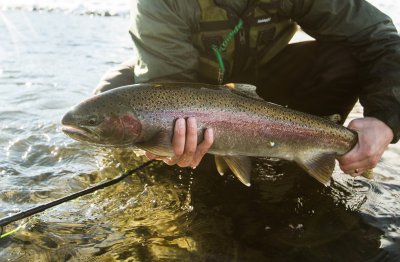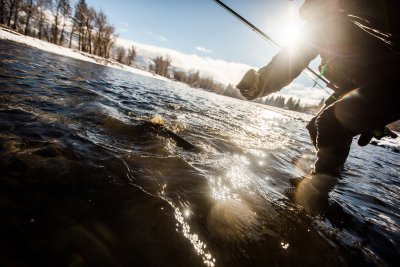WWU’s Leo Bodensteiner Working to Solve the Puzzle of the Skagit River Steelhead
There comes a time in the life of every young coastal rainbow trout when a combination of factors – genetic makeup, water conditions, its current health and size, and more – cause it to ask itself one very important question: To go to sea, or not go to sea?
Those that opt to leave the river systems of the West and head out into the ocean (their freshwater brethren remain blissfully ignorant of all this drama) become steelhead, with their time in the Pacific spent becoming a jumbo-sized rainbow that weighs 4 to 5 times that of its river- and lake-dwelling kin.
The question of how and why a rainbow trout makes that decision to go to sea or stay home lies at the heart of the research of Western Washington University Professor of Environmental Sciences Leo Bodensteiner.
“The steelhead has the most complex life history of any fish on the West Coast,” said Bodensteiner. “There is still so much about what happens to turn a rainbow trout into a steelhead that we just don’t know.”
Not surprisingly, steelhead have long been prized as a food source by the region’s Indigenous peoples as well as premium target of recreational and commercial fishers from Southern California to the Aleutian Islands. But dams, habitat loss, and warming river temperatures have caused a decline in steelhead numbers up and down the West Coast.
Bodensteiner has received a pair of grants, one from the Upper Skagit Indian Tribe, another from the U.S Forest Service, to answer some of these questions.
“Trying to forecast what the next year’s steelhead numbers on the Skagit will be always involves a huge amount of supposition, because of the fish's complex life history,” he said.
At the heart of the matter lies the ambiguity in the relationship between the rainbow and the steelhead.
“Chinook and coho come up the river, spawn out, and in the process make other chinook or coho,” he said. “A rainbow that spawns in a tributary of the Skagit could produce a juvenile that will elect to go to sea and become a steelhead. A steelhead that returns to spawn on the Skagit doesn’t produce other steelhead, it produces rainbows that, just like their brothers and sisters, may or may not elect to go to sea in the future. So you can see where predictions become difficult.”
An important of his research involves extracting otoliths – tiny bone-like structures in the heads of the steelhead – and examining them under Western’s mass spectrometer and scanning electron microscope with help from WWU Geology research associate Nicole McGowan to get the otolith’s elemental composition.
“You can grind these otoliths into thin sections and, using this kind of ‘elemental mapping,’ read them like rings on a tree. You can see when they went to sea and when they came back into fresh water, and for how long. It’s a very revealing way to get a look at the fish’s life history,” he said.
Understanding how young rainbows on the cusp of making that all-important life choice live in the Skagit’s tributaries is another part of Bodensteiner’s research. Last summer, he and a number of undergraduate students from Western sampled stretches of a number of tributaries of the Skagit, implanting PIT (Passive Integrated Transponder) tags in juvenile rainbows that were identified as potential steelhead.
They could then track the rainbows using the transponder tags to examine their behavior before they went to sea.
Bodensteiner said getting a better understanding on what the young fish are doing using the PIT tag, and examining the life history of the adult fish through the otoliths, helps to paint a clearer picture of the factors that influence the choice the young rainbows make. And a more viable, more accurate way to forecast returning steelhead numbers will go a long way to protecting the steelhead in numbers that could, in the long run, allow its numbers to rebound.
“That is certainly the goal of all the organizations involved in this work – more steelhead in the Skagit, over the long term,” he said.
For more information on Bodensteiner’s work with steelhead on the Skagit River, contact him at leo.bodensteiner@wwu.edu.

